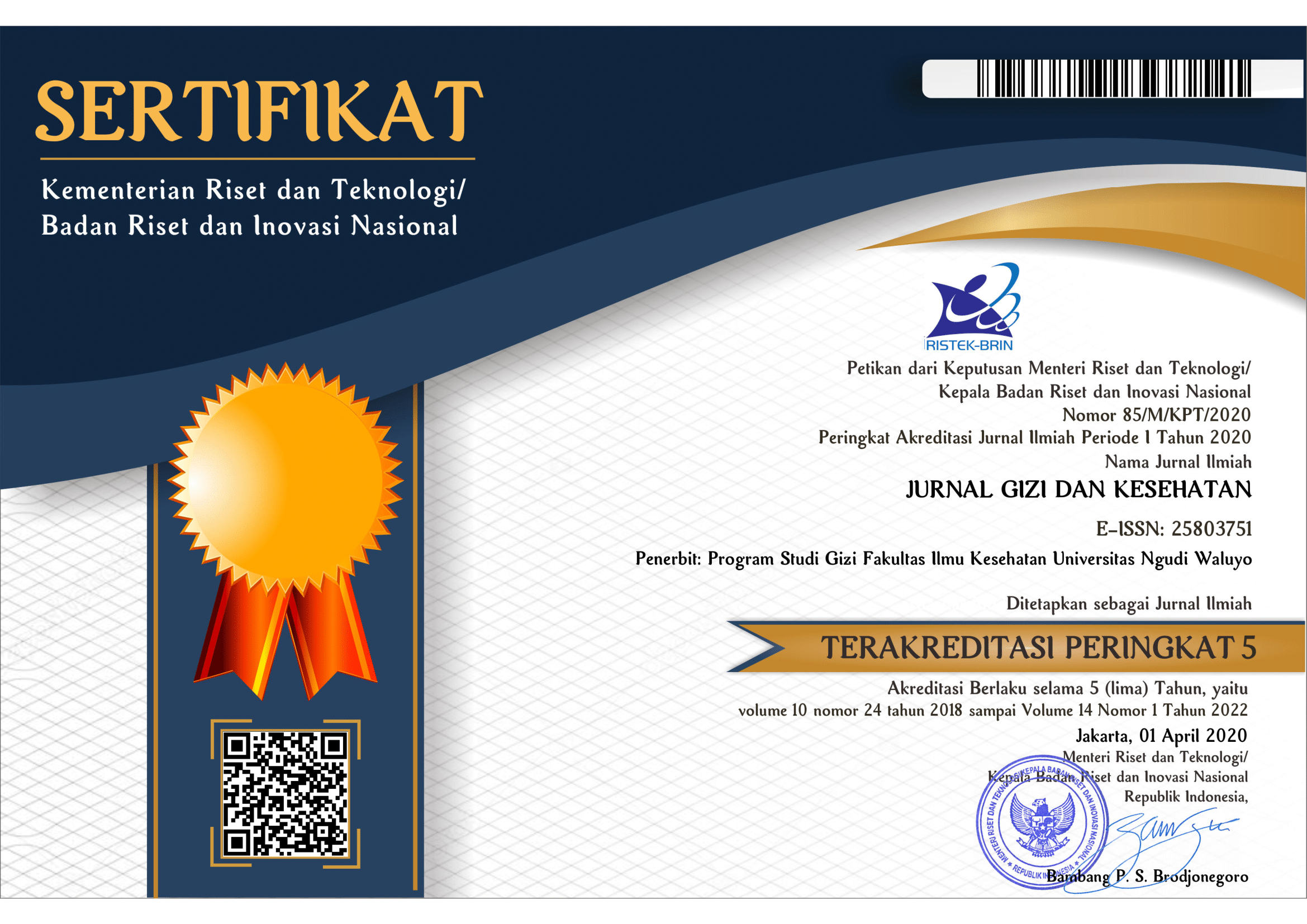Studi Kepustakaan Gambaran Obesitas pada Ibu Rumah Tangga di Dunia
The Description of Obesity Among Housewifes in The World
DOI:
https://doi.org/10.35473/jgk.v14i1.243Keywords:
Anak-Anak, Konsumsi Buah dan Sayur, Perubahan Perilaku, Pendidikan GiziAbstract
Background Obesity is a rapidly growing public health problem affecting many countries in the world because of its prevalence, cost, and impact on health. The prevalence of obesity worldwide according to WHO is generally more common in women (13%) than men (11%). From 1980 to 2013 the prevalence of overweight and obesity among housewives in the world continued to increase. The increase in obesity in housewives is caused by several factors, especially lifestyle changes including decreased physical activity and excess intake of high-energy foods. Obesity is a serious problem because it reduces the quality of life and causes death worldwide. Purpose This literature study aims to describe obesity that occurs in housewives around the world along with the risk factors, management and prevention of obesity. Discussion Housewives are one of the groups at high risk of obesity. Obesity in women is influenced by various factors where the majority can still be prevented from now on. Conclusion Overweight and obesity can be defined as excessive accumulation of body fat. Obesity causes multifactorial or can be influenced by various risk factors. Obesity is more experienced by women with supporting factors such as: age, genetics, education level, multiparity, ethnicity, socio-economics, physical activity, and lifestyle. The risk factors that cause obesity consist of multifactors so that the handling of obesity involves many sectors.
ABSTRAK
Latar Belakang Obesitas merupakan masalah kesehatan masyarakat yang berkembang pesat serta mempengaruhi banyak negara di dunia karena prevalensi, biaya, dan dampak terhadap kesehatan. Prevalensi obesitas menurut WHO umumnya terjadi pada wanita (sebanyak 13%) dibanding pria. Sejak tahun 1980 hingga 2013 prevalensi kelebihan berat badan dan obesitas pada ibu rumah tangga di dunia terus meningkat. Obesitas ibu rumah tangga diakibatkan oleh beberapa faktor, terutama perubahan gaya hidup termasuk penurunan aktivitas fisik dan kelebihan asupan makanan berenergi tinggi. Obesitas merupakan permasalahan serius karena mengakibatkan pengurangan kualitas hidup serta menyebabkan kematian di seluruh dunia. Tujuan Studi literatur ini bertujuan untuk menggambarkan obesitas yang terjadi pada ibu rumah tangga di seluruh dunia beserta faktor resiko, penatalaksanaan serta pencegahan obesitas melalui sumber kepustakaan. Diskusi Ibu rumah tangga merupakan salah satu kelompok beresiko tinggi terkena obesitas. Obesitas pada wanita dipengaruhi berbagai macam faktor di mana mayoritas masih dapat dicegah sejak sekarang. Kesimpulan Berat badan berlebih dan obesitas dapat didefinisikan sebagai akumulasi lemak tubuh secara berlebihan. Obesitas penyebabnya multifaktoral atau dapat dipengaruhi berbagai faktor risiko. Obesitas lebih banyak dialami oleh wanita dengan faktor pendukung seperti: usia, genetik, tingkat pendidikan, multiparitas, etnis, sosio-ekonomi, aktivitas fisik, dan gaya hidup. Faktor risiko yang menyebabkan obesitas terdiri dari multifactor sehingga penanganan dari obesitas melibatkan banyak sektor.
Downloads
References
Abdul Aziz, N. S. et al. Influence of co-morbidity on body composition changes after weight loss intervention among overweight housewives: a follow-up study of the MyBFF@home. BMC Womens Health , 115 (2018).
Apriaty,L. Faktor Risiko Obesitas Ibu Rumah Tangga di Kelurahan Bendungan Kecamatan Gajahmungkur Kota Semarang 7.(2015).
Barasi, M. E. At a Glance Ilmu Gizi. Jakarta: Penerbit Erlangga, 2007.
Fuadianti, T. F. Diajukan kepada Fakultas Psikologi Universitas Muhammadiyah Surakarta. 22 (2018).
Ghee, L. K. A Review of Adult Obesity Research in Malaysia. , 19 (2016).
Gouda, J. & Prusty, R. K. Overweight and Obesity among Women by Economic Stratum in Urban India. , 10 (2014).
Hareesha, E., Basha, D. A., Naik, J. L. & Reddy, K. S. N. Association Between Body Mass Index and Blood Pressure among Housewives of Tirupati Town, Andhra Pradesh. 6 (2016).
Jääskeläinen, A. et al. Stress-related eating, obesity and associated behavioural traits in adolescents: a prospective population-based cohort study. BMC Public Health , 321 (2014).
Kim, L. P. & Mallo, N. Maternal Perceptions of Self-Weight and Child Weight May Influence Milk Choice of Participants in the Special Supplemental Nutrition Program for Women, Infants, and Children (WIC). J. Obes. 2019, 1–9 (2019).
Kumar, A. The impact of obesity on cardiovascular disease risk factor. Asian J. Med. Sci. , 1–12 (2018).
Mbochi, R. W., Kuria, E., Kimiywe, J., Ochola, S. & Steyn, N. P. Predictors of overweight and obesity in adult women in Nairobi Province, Kenya. BMC Public Health , 823 (2012).
Mihardja, L. & Soetrisno, U. Prevalence and Determinant Factors for Overweight and Obesity and Degenerative Diseases Among Young Adults in Indonesia. J. ASEAN Fed. Endocr. Soc. , 77–81 (2012).
Muda, W., Kuate, D., Jalil, R., Nik, W. & Awang, S. Self-perception and quality of life among overweight and obese rural housewives in Kelantan, Malaysia. Health Qual. Life Outcomes , 19 (2015).
Musaiger, A. O. et al. Prevalence of Overweight and Obesity among Adolescents in Seven Arab Countries: A Cross-Cultural Study. J. Obes. 2012, 1–5 (2012).
Navadeh, S., Sajadi, L., Mirzazadeh, A., Asgari, F. & Haghazali, M. Housewives’ Obesity Determinant Factors in Iran; National Survey - Stepwise Approach to Surveillance. , 15 (2011).
Nikooyeh,B.et al. Prevalence of Obesity and Overweight and Its Associated Factors in Urban Adults from West Azerbaijan, Iran:The National Food and Nutritional Surveillance Program (NFNSP). Nutr. Food Sci. Res. , 21–26 (2016).
Nurrahmawati, F. & Fatmaningrum, W. Hubungan Usia, Stres, dan Asupan Zat Gizi Makro dengan Kejadian Obesitas Abdominal pada Ibu Rumah Tangga di Kelurahan Sidotopo, Surabaya. Amerta Nutr. , 254 (2018).
Pujilestari, C. U. et al. Socioeconomic inequality in abdominal obesity among older people in Purworejo District, Central Java, Indonesia – a decomposition analysis approach. Int. J. Equity Health , 214 (2017).
Ramadhaniah, R., Julia, M. & Huriyati, E. Durasi tidur, Asupan Energi, dan Aktivitas Fisik dengan Kejadian Obesitas pada Tenaga Kesehatan Puskesmas. J. Gizi Klin. Indonesia.,85(2014).
Rathnayake, K. M., Roopasingam, T. & Dibley, M. J. High carbohydrate diet and physical inactivity associated with central obesity among premenopausal housewives in Sri Lanka. BMC Res. Notes 7, 564 (2014).
Ryanne, J. D. Program Studi Kesejahteraan Sosial Fakultas Ilmu Dakwah dan Ilmu Dakwah dan Ilmu Komunikasi Universitas Islam Negeri Syarif Hidayatullah 1437 H/2015 M. 230 (2015).
Sadeghi, M. et al. Do Intervemtion Strategies of Women Healthy Heart Project (WHHP) Impact on Differently on Working and Housewifes? 7.
Sanz-de-Galdeano, A. The Obesity Epidemic in Europe. 32.
Tarasuk, V., Fafard St-Germain, A.-A. & Mitchell, A. Geographic and socio-demographic predictors of household food insecurity in Canada, 2011–12. BMC Public Health , 12 (2019).
Viljakainen,J.et al.Eating Habits and Weight Status in FinnishAadolescents. Public Health Nutr. , 2617–2624 (2019).
Wibawani, A. P., Trihadi, D. & Tyagita, N. Hubungan Antara Faktor Risiko Obesitas dengan Kejadian Diabetes Mellitus Tipe 2 Studi Cross Sectional pada Pasien Rawat Jalan Rumah Sakit Umum Daerah Kota Semarang Tahun 2016.12.









